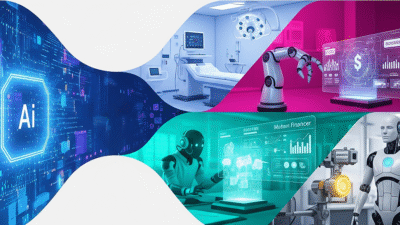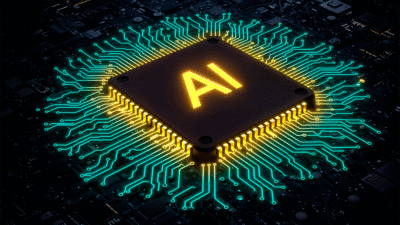AI/ML Development Services focus on creating intelligent software solutions that leverage artificial intelligence and machine learning to solve complex business challenges. These services include designing, developing, and deploying models that can learn from data, recognize patterns, and make real-time decisions with minimal human intervention.
From predictive analytics and natural language processing to image recognition and automation, AI/ML technologies enhance efficiency, personalization, and innovation across industries. Businesses use these solutions to improve customer experience, streamline operations, and gain deeper insights from data. With advancements in algorithms, computing power, and big data, AI/ML services are becoming essential for digital transformation and competitive growth.
Table of Contents
- Introduction
- Understanding Artificial Intelligence and Machine Learning
- Key Components of AI/ML Development
- Types of AI/ML Development Services
- Industries Leveraging AI/ML Development
- AI/ML Development Tools and Technologies
- Benefits of Investing in AI/ML Development Services
- Challenges in AI/ML Development
- Conclusion and Future Outlook
1. Introduction
- In today’s digital-driven world, businesses are rapidly embracing Artificial Intelligence (AI) and Machine Learning (ML) to streamline operations, enhance customer experiences, and drive innovation. AI/ML development services involve creating intelligent systems that learn from data, automate tasks, and support smarter decision-making.
- These services include building custom algorithms, training models, and integrating them into existing platforms to solve real-world problems. From personalized recommendations to fraud detection and predictive analytics, AI/ML solutions are transforming how industries operate. With access to powerful tools, cloud infrastructure, and expert development teams, companies of all sizes can now leverage these technologies. However, successful implementation requires technical know-how, data strategy, and ongoing optimization.
- This blog explores the full scope of AI/ML development services covering how they work, their impact across sectors, common challenges, and how to choose the right development partner. It’s a comprehensive guide for businesses looking to tap into the power of intelligent automation and data-driven innovation.
2. Understanding Artificial Intelligence and Machine Learning
To fully grasp the impact and scope of AI/ML development services, it’s essential to first understand what Artificial Intelligence and Machine Learning actually are, how they differ, and how they work together.
What is Artificial Intelligence (AI)?
Artificial Intelligence (AI) refers to the simulation of human intelligence in machines that are programmed to think, reason, learn, and make decisions. The core idea behind AI is to enable machines to perform tasks that typically require human cognition such as understanding language, recognizing images, solving problems, or making decisions. AI systems are designed to mimic human behavior and adapt to new inputs, improving performance over time.
AI can be categorized into two main types:
- Narrow AI: Designed for specific tasks (e.g., voice assistants like Siri or recommendation engines).
- General AI: A theoretical form of AI that would perform any intellectual task a human can do (still largely under research).
What is Machine Learning (ML)?
Machine Learning (ML) is a subset of AI that focuses on developing algorithms that allow computers to learn from data and make predictions or decisions without being explicitly programmed. ML models identify patterns in data and use these patterns to make informed decisions, often with increasing accuracy as they are exposed to more data.
ML can be broadly classified into:
- Supervised Learning: Models are trained on labeled datasets (e.g., spam vs. not spam emails).
- Unsupervised Learning: Models analyze and group unlabeled data (e.g., customer segmentation).
- Reinforcement Learning: Models learn through trial and error, receiving feedback from their actions (e.g., training robots or AI in games).
The Role of Data in AI/ML
Data is the foundation of both AI and ML. Without quality data, these systems cannot learn or function effectively. Data helps train models, validate them, and refine their accuracy. In real-world AI/ML development, this involves collecting structured and unstructured data, cleaning it, labeling it (if needed), and using it to train algorithms.
The more diverse and extensive the dataset, the better the machine can learn and generalize its knowledge. This is why data strategy is a key component of AI/ML development services.
Key Technologies Behind AI/ML
AI and ML systems often rely on several supporting technologies:
- Neural Networks and Deep Learning: Mimic the human brain to process complex data inputs (used in image and speech recognition).
- Natural Language Processing (NLP): Enables machines to understand and generate human language.
- Computer Vision: Allows machines to interpret and process visual information.
- Big Data & Cloud Computing: Provide the infrastructure and scale required for data processing and model training.
Real-World Examples
- AI in Healthcare: AI systems analyze medical data to assist in diagnosis and treatment plans.
- ML in Finance: Models predict credit risk, detect fraud, and optimize trading strategies.
- AI in Retail: Personalized shopping experiences and inventory optimization.
- ML in Manufacturing: Predictive maintenance and quality control.
3. Key Components of AI/ML Development
Developing effective AI and ML systems involves more than just writing algorithms. It is a structured process that integrates data engineering, statistical modeling, computational power, and continuous iteration. To build intelligent solutions that deliver real value, businesses must understand and address each phase of the AI/ML development lifecycle.
Here are the key components that form the foundation of AI/ML development:
1) Data Collection and Acquisition
Every AI/ML project begins with data. Data fuels the learning process, and the quality, variety, and volume of data directly impact model performance. This data can be:
- Structured (e.g., spreadsheets, databases)
- Unstructured (e.g., images, videos, emails)
- Semi-structured (e.g., JSON, XML)
2) Data Cleaning and Preprocessing
Raw data is often noisy, incomplete, or inconsistent. Before any model can be trained, data needs to be cleaned and prepared:
- Handling missing values
- Removing duplicates
- Filtering outliers
- Normalizing or standardizing values
3) Exploratory Data Analysis (EDA)
EDA involves using statistical methods and visualization tools to understand data patterns, correlations, and trends. It helps in:
- Identifying potential predictors
- Understanding data distribution
- Spotting relationships and dependencies
- Selecting relevant features
4) Model Selection and Algorithm Design
This is the heart of AI/ML development. At this stage, developers select the type of machine learning algorithm that best suits the problem:
- Linear Regression, Logistic Regression
- Decision Trees, Random Forests, Gradient Boosting
- Support Vector Machines
- Neural Networks and Deep Learning
- K-means Clustering, Principal Component Analysis (PCA)
5) Model Training and Evaluation
Once the model is selected, it’s trained on the dataset using labeled examples (in supervised learning). The goal is for the algorithm to learn the underlying relationships in the data. After training, the model is tested using unseen data to evaluate its performance using metrics like:
- Accuracy
- Precision and Recall
- F1 Score
- Mean Squared Error
6) Model Monitoring and Maintenance
AI/ML models are not “set and forget.” As new data flows in and environments change, models can become outdated or biased. Continuous monitoring helps ensure models remain accurate, fair, and effective:
- Retraining the model periodically
- Logging predictions and feedback
- Monitoring latency and performance in real-time
4. Types of AI/ML Development Services
AI/ML development services encompass a wide range of solutions tailored to meet the diverse needs of businesses across industries. From automating customer interactions to predicting user behavior, these services leverage intelligent algorithms to solve complex problems and optimize business processes.
1) Machine Learning Model Development
This is the core service where data scientists and engineers design, train, and deploy machine learning models based on specific business objectives. These models can perform tasks such as:
- Predicting sales or demand
- Detecting fraud or anomalies
- Classifying customer feedback
- Recommending products or content
2) Natural Language Processing (NLP)
NLP enables machines to understand, interpret, and generate human language. This AI service is widely used in:
- Chatbots and virtual assistants
- Sentiment analysis
- Automated summarization
- Text classification
- Language translation
3) Computer Vision
Computer vision services help machines “see” and interpret visual information such as images and videos. It’s particularly valuable in industries like healthcare, security, manufacturing, and retail. Common applications include:
- Facial recognition
- Object detection and tracking
- Image classification
- Medical imaging analysis
- Quality inspection in manufacturing
4) Predictive Analytics
Predictive analytics uses machine learning and statistical algorithms to forecast future outcomes based on historical data. Businesses use these services to:
- Anticipate customer churn
- Forecast inventory needs
- Identify credit risks
- Predict equipment failures
5) AI-Powered Chatbots and Virtual Assistants
These tools use AI, ML, and NLP to automate communication and provide 24/7 customer support. Advanced chatbots can:
- Understand context and user intent
- Resolve issues without human intervention
- Integrate with CRM and knowledge bases
- Learn from user interactions over time
6) Speech Recognition and Voice AI
Voice-based interfaces are becoming mainstream thanks to virtual assistants like Alexa, Siri, and Google Assistant. AI services in this category include:
- Speech-to-text transcription
- Voice authentication
- Voice-enabled search and navigation
- Real-time language translation

5. Industries Leveraging AI/ML Development
AI and ML technologies are transforming industries by offering intelligent solutions to streamline operations, personalize services, and make better data-driven decisions. From automating tedious tasks to identifying patterns that drive innovation.
1) Healthcare
AI/ML has revolutionized the healthcare sector by improving diagnostics, patient care, and operational efficiency. Applications include:
- Predictive Analytics for identifying disease risks
- Medical Imaging Analysis using deep learning
- Personalized Treatment Plans through patient data modeling
- Virtual Health Assistants for 24/7 support
2) Finance and Banking
The financial sector leverages AI/ML to improve security, automate trading, and enhance customer experience. Key applications include:
- Fraud Detection and Prevention using anomaly detection
- Credit Scoring with more accurate risk analysis
- Algorithmic Trading for real-time stock decisions
- Chatbots and virtual assistants for customer support
3) Retail and eCommerce
Retailers use AI/ML to better understand customer behavior and optimize inventory and marketing. Use cases include:
- Product Recommendation Engines
- Customer Sentiment Analysis through NLP
- Dynamic Pricing Algorithms
- Visual Search and image recognition
4) Manufacturing
AI/ML helps manufacturers improve production efficiency, reduce downtime, and ensure quality. Applications include:
- Predictive Maintenance for machinery
- Process Automation and robotics
- Defect Detection via computer vision
- Supply Chain Optimization
- Energy Usage Monitoring
5) Transportation and Logistics
Logistics and transport companies apply AI to manage routes, reduce fuel usage, and predict delays. Use cases include:
- Route Optimization
- Autonomous Vehicles and Drones
- Predictive Vehicle Maintenance
6. AI/ML Development Tools and Technologies
The successful implementation of Artificial Intelligence and Machine Learning projects relies heavily on the right set of tools and technologies. These tools help data scientists, developers, and engineers build, train, deploy, and monitor intelligent systems effectively.
1) Programming Languages
Several programming languages are widely used in AI/ML development. Among them, the most popular include:
- Python: The most preferred language due to its extensive libraries (TensorFlow, scikit-learn, PyTorch) and easy syntax.
- R: Ideal for statistical computing and data analysis.
- Java & C++: Used for high-performance AI applications like natural language processing and real-time systems.
2) Machine Learning Frameworks
Frameworks make it easier to design, build, and train ML models. Common frameworks include:
- TensorFlow: Open-source library by Google, great for deep learning and neural networks.
- PyTorch: Developed by Facebook, known for its dynamic computation graph and ease of debugging.
- scikit-learn: A lightweight Python library ideal for traditional ML tasks like classification, regression, and clustering.
3) Deep Learning Libraries
Deep learning involves complex neural networks and large-scale data. Libraries include:
- Theano: One of the earliest deep learning libraries, now mostly used for legacy systems.
- MXNet: Scalable deep learning framework supported by Apache.
- CNTK (Microsoft Cognitive Toolkit): Used for commercial scale, distributed deep learning.
4) Data Processing & Analytics Tools
Data is at the heart of AI/ML. The following tools help clean, transform, and analyze data:
- Pandas: A Python library for data manipulation and analysis.
- NumPy: Used for numerical computations with high-performance multidimensional arrays.
- Apache Spark: A fast, distributed processing engine used for big data processing and real-time analytics.
5) Model Deployment & MLOps Platforms
Once a model is trained, it needs to be deployed, monitored, and maintained. This is where MLOps (Machine Learning Operations) comes in:
- Docker & Kubernetes: Containerization and orchestration tools for deploying AI models at a scale.
- MLflow: Open-source platform for managing the ML lifecycle including experimentation, reproducibility, and deployment.
- Kubeflow: Kubernetes-native platform for deploying ML pipelines.
7. Benefits of Investing in AI/ML Development Services

In today’s data-driven world, businesses across every industry are racing to harness the power of Artificial Intelligence (AI) and Machine Learning (ML) to gain a competitive edge. Investing in AI/ML development services offers a transformative set of benefits that go beyond automation. It drives innovation, enhances decision-making, and delivers exceptional customer experiences.
1) Improved Decision-Making
AI/ML systems analyze massive volumes of data at speed and scale, delivering insights that are data-driven and predictive. These systems identify trends, anomalies, and hidden patterns that would be nearly impossible for humans to detect manually. With actionable intelligence, leaders can make faster, more informed decisions, whether it’s forecasting market demand, optimizing pricing strategies, or identifying emerging business risks.
2) Enhanced Customer Experience
Machine learning algorithms can personalize user experiences in real time by analyzing user behavior, preferences, and past interactions. AI-powered chatbots, recommendation engines, and dynamic content delivery systems offer tailor-made solutions, driving customer engagement and satisfaction. This level of personalization builds stronger relationships, improves retention, and ultimately increases revenue.
3) Operational Efficiency and Automation
AI/ML technologies significantly reduce human effort by automating repetitive, rules-based, and time-consuming tasks. From automating data entry and document processing to streamlining customer service and supply chain logistics, AI-driven automation enhances efficiency and accuracy. This allows businesses to reallocate human resources to more strategic, creative, and value-added activities.
4) Cost Reduction
While the initial investment in AI/ML development may seem substantial, the long-term savings can be substantial. Automation, process optimization, predictive maintenance, and resource planning minimize waste and downtime, leading to cost reductions across departments. AI also helps in fraud detection and error reduction, saving organizations from potential financial losses.
5) Scalability and Adaptability
AI/ML systems are built to learn and adapt over time. As businesses grow and generate more data, machine learning models become more accurate and insightful. These systems are scalable, meaning they can handle increasing workloads and adjust to new business requirements, making them a perfect fit for dynamic and expanding organizations.
8. Challenges in AI/ML Development
While Artificial Intelligence and Machine Learning offer immense opportunities, the path to successful implementation is often complex and filled with hurdles. Developing robust, reliable, and scalable AI/ML systems requires more than just powerful algorithms.
1) Data Availability and Quality
AI/ML models thrive on data. The success of any algorithm heavily depends on the quality, quantity, and relevance of the data used for training and validation.
- Data scarcity is common in niche or emerging industries.
- Imbalanced or biased datasets can lead to unfair or inaccurate predictions.
- Noisy, incomplete, or outdated data can compromise model accuracy and reliability.
2) Complex Model Selection and Tuning
Selecting the right machine learning model is a challenging task. Each model be it decision trees, neural networks, or support vector machines.
- Hyperparameter tuning can be time-consuming and computationally expensive.
- Overfitting (model too closely fitted to training data) and underfitting (model too simplistic) must be carefully managed.
3) High Computational Requirements
Training sophisticated AI/ML models often demands significant computational power, especially for deep learning tasks involving large datasets.
- The need for high-performance GPUs or TPUs.
- Increased energy consumption and infrastructure costs.
- Limited access to cloud computing resources for small businesses or startups.
4) Lack of Skilled Talent
There is a global shortage of professionals who possess the required expertise in data science, machine learning, deep learning, and MLOps.
- Hiring bottlenecks for companies scaling AI projects.
- Inefficiencies in AI implementation due to inexperience.
5) Interpretability and Explainability
Many advanced AI/ML models especially deep neural networks operate as black boxes. This lack of transparency poses problems in:
- Regulated industries like healthcare and finance where model decisions must be explainable.
- User trust, as stakeholders may hesitate to rely on opaque models.
- Debugging and improvement, as it’s harder to understand why a model behaves a certain way.
9. Conclusion and Future Outlook
- Artificial Intelligence and Machine Learning are no longer futuristic technologies. They are present-day enablers of innovation, efficiency, and growth across every industry. From automating workflows and delivering personalized user experiences to enhancing security and improving decision-making, AI/ML development services offer immense potential for forward-thinking businesses.
- However, successful adoption is not just about using the latest algorithms or tools. It involves a well-rounded strategy that includes high-quality data, scalable infrastructure, a skilled team, ethical considerations, and a long-term vision. Companies that understand these elements and invest wisely in AI/ML initiatives will gain a distinct competitive advantage in the years ahead.
- Looking forward, the future of AI/ML holds even more promise. Technologies like generative AI, reinforcement learning, federated learning, and explainable AI are poised to redefine how machines interact with humans and each other. As AI becomes more accessible through no-code platforms and cloud-based solutions, even small and medium-sized enterprises will be able to harness its power.
- Moreover, cross-industry collaboration and regulatory developments will shape a more responsible, inclusive, and transparent AI landscape. AI/ML will continue evolving to become more intuitive, autonomous, and integral to digital transformation efforts worldwide.
- In conclusion, embracing AI/ML development today means preparing your business for tomorrow. With the right approach and partner, organizations can move from experimenting with AI to fully operationalizing it can unlock sustainable growth, smarter services, and a future built on innovation.




